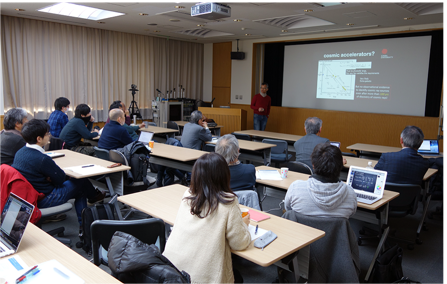“宇宙射线”是以高能量从宇宙中传播的粒子。在最初的宇宙射线研究中,“宇宙射线”是质子和氦核等带电粒子,但近年来,中微子、伽马射线和引力波(引力子)等不带电的基本粒子也被认为是“宇宙射线”,拓宽了宇宙射线研究的范围。由于宇宙射线的传播距离很长,比地球的大小还大,并且被加速到极高的能量,它们有助于对地面加速器实验中无法进行的基本粒子的研究。ICRR使用宇宙射线对宇宙和基本粒子进行基础研究。宇宙射线研究所的历史始于海拔2770米的乘鞍山上的一个名为朝日小屋的宇宙射线观测小屋,于1953年发展成为东京大学的宇宙射线天文台(俗称乘鞍天文台)。宇宙射线天文台随后于1976年重组为东京大学宇宙射线研究所(ICRR)。
ICRR有中微子和天体粒子部门、高能宇宙射线部门以及天体物理学和重力部门三个研究部门,可有效地开展科学研究活动。ICRR是日本政府的“国际联合研究/使用中心”,日本和其他国家/地区的宇宙射线研究人员在ICRR开展了150多个大学间研究项目,研究所的大部分科学成果是来自世界各地许多机构的研究人员共同努力的结果。
在ICRR的宇宙射线研究中,已经使用大型设备进行高度敏感的观测。在神冈天文台,研究使用安装在地下1000米处的5万吨级水切伦科夫探测器(Super-Kamiokande)进行观测,观察大气中宇宙射线相互作用产生的中微子和来自太阳的中微子。此外,还进行了从东海到神冈(T2K)的人工中微子实验。在神冈的同一座山上,建造了一台臂长为3公里的激光干涉仪(大型低温引力波望远镜(KAGRA)),用于引力波观测。

Cosmic rays are particles that travel from the universe at high energies. In the original study of cosmic rays, "cosmic rays" were charged particles such as protons and helium nuclei, but in recent years, uncharged elementary particles such as neutrinos, gamma rays and gravitational waves (gravitons) have also been considered "cosmic rays," broadening the scope of cosmic ray research. Because cosmic rays travel long distances, are larger than the size of the Earth, and are accelerated to extremely high energies, they aid in the study of elementary particles that cannot be performed in ground-based accelerator experiments. The ICRR uses cosmic rays to conduct fundamental research on the universe and elementary particles.
The history of the Institute for Cosmic Ray Research began with a cosmic ray observation hut named Asahi Hut on Mount Yayasan at 2,770 meters above sea level, which developed into the Cosmic Ray Observatory (commonly known as Yayasan Observatory) at the University of Tokyo in 1953. The Cosmic Ray Observatory was subsequently reorganized as the Institute for Cosmic Ray Research (ICRR) at the University of Tokyo in 1976.
The ICRR has three research departments, namely Neutrino and Celestial particle Department, high-energy Cosmic Ray Department and Astrophysics and gravity Department, which can effectively carry out scientific research activities. The ICRR is the "International Joint Research/Use Center" of the Japanese government. Cosmic ray researchers from Japan and other countries conduct more than 150 interuniversity research projects at the ICRR. Most of the scientific achievements of the Institute are the result of the joint efforts of researchers from many institutions around the world.
In cosmic ray research at the ICRR, highly sensitive observations have been made using large equipment. At Kamioka Observatory, the research used the 50,000-ton water Cherenkov detector (Super-Kamiokande), located 1,000 meters underground, to observe neutrinos from cosmic ray interactions in the atmosphere and those from the sun. In addition, an artificial neutrino experiment was conducted from Tokai to Kamioka (T2K). On the same mountain in Kamioka, a laser interferometer (the Large Cryogenic Gravitational-Wave Telescope (KAGRA)) with an arm length of 3 km was built for gravitational wave observation.